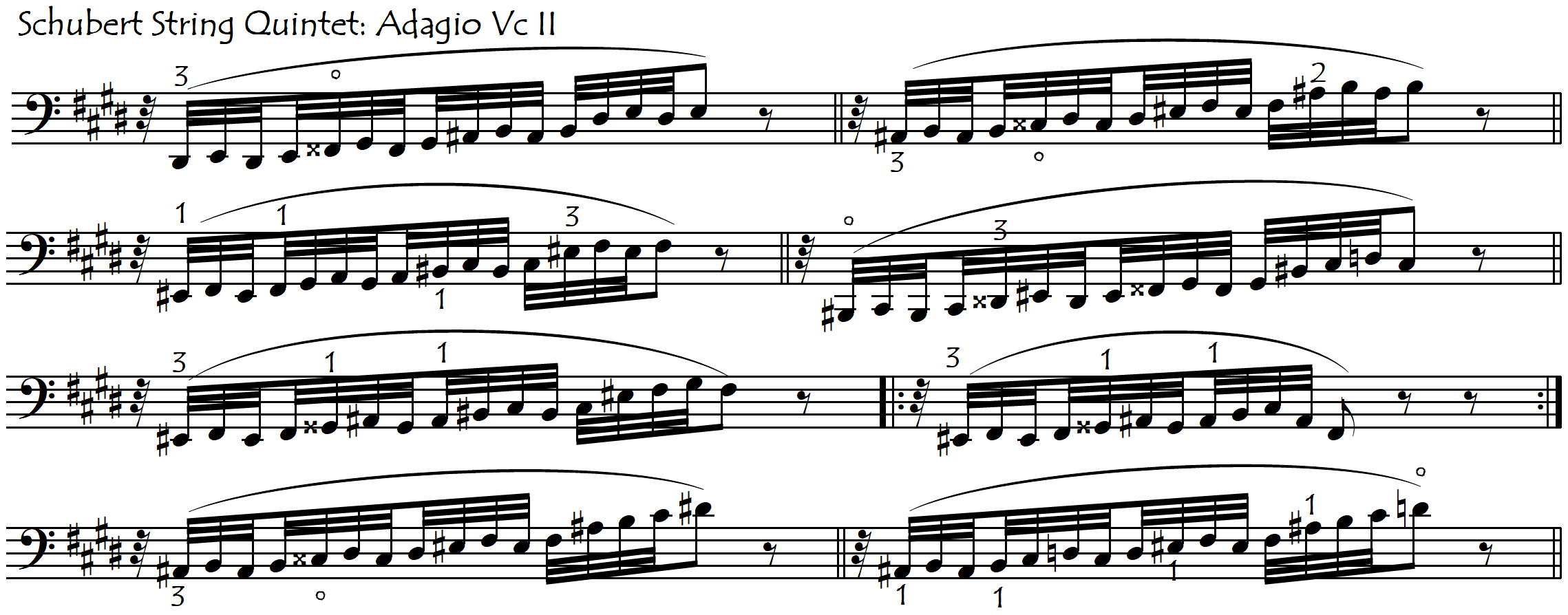Chromatics For Cellists
The difficulty of reading chromatic passages is discussed in Music Reading and Notation Problems. The difficulties of hearing (imagining the pitches with our internal ear) chromatic passages are looked at on the Ear Training page. Here however we will look at the mechanical problems associated with playing chromatic passages.
We are so used to playing tonal, scalic, singable music, that when we come across complex chromatic passages we have to change gear. We can no longer easily imagine or sing the pitches and thus need to start playing “by numbers” like a computer …….. or develop our aural and harmony skills to a higher degree of sophistication (to the level of the composer).
SIMPLE REGULAR CHROMATIC SCALES
Simple chromatic scales provide us with a good starting point for working on our chromatic skills. Symmetrical, predictable, standardised, with one semitone between each note, the reading, aural, and general brain difficulties that they present are reduced to a (chromatic) minimum. But this chromatic minimum is still significant and challenging. Playing even the most simple chromatic scales is quite a specialised skill and can be somewhat problematic, especially at high speed. From both an aural and a fingering point of view they pose unique problems and we will therefore need to work on them.
All those semitones piled on top of each other can be hard to hear with our inner ear and the number of different fingering possibilities is enormous. Because of this complexity of the ear-brain-hand-eye information processing task, it can be very easy to get into a coordination tangle during the scale and get lost somewhere along the way. Fortunately, what looks like complex notation (with many sharps and flats) doesn’t in fact normally constitute a great reading problem because we play regular chromatic scales more by interval (by ear) than by note-names.
There is a great difference between playing a chromatic scale across the open strings, on one string, or in thumb position: aurally they are identical but the physical movements required for these three situations are very different:

Whether we play them across the strings or up and down the same string we have a large choice of possible fingerings. In the neck region, the standard over-the-open-strings formula “pattern” works well ….. sometimes ….

This “standard” formula has the advantage that we don’t need to think about (or remember) which fingering we will be using, but very often it might be easier to play the scale using a fingering that takes into account the particular rhythmic groupings of the passage so as to be able to shift on the beats:

Here are some links to practice material for regular chromatic scales, with their large variety of fingerings:
Chromatic Scales Across Open Strings: EXERCISES Chromatic Scales Across Open Strings: STUDY
Chromatic Scales Across Strings Without Open Strings: EXERCISES
Chromatic Scales On One String: EXERCISES Chromatic Scales: REPERTOIRE EXCERPTS
ONE FINGER CHROMATIC SCALES ON ONE STRING
A special case scenario occurs with same-string chromatic scales that are played with only one finger. There are really only two reasons for which we would play an entire scale passage on the same finger:
- if the scale is in double-stops

- if it needs to be played so fast that the use of standard fingerings (with shifts and changes of finger) is impossible.

The following links take us to material for working on these specific “one-finger chromatic scale” situations:
One String One Finger Chromatic Scales: EXERCISES
Doublestopped One Finger Chromatic Scales: EXERCISES
One Finger Chromatic Scales (One String and Doublestopped): REPERTOIRE EXCERPTS
IRREGULAR CHROMATIC PASSAGES
The most problematic chromatic scale passages are those that are interspersed with occasional non-chromatic intervals. Apart from the reading problems that they pose, these types of passage often pose fingering problems because, unlike for standard chromatic scales, there is usually no “system” or pattern that we can rely on. Look at the following passage from the overture to Wagner’s opera “Tannhäuser”. Writing a bracket over all the tone intervals makes the reading much simpler.

This passage continues on, and then comes back later in a more extended version in another key (with completely different fingerings). On a bad day, we could be tempted to consider particularly complex passages like these as “chromatic slime” because of the amount of work that is necessary to play them accurately and up to speed. We can, however, also look on them as a sort of musical test (a “smear test”?) that prepares us for the complexities of modern music and, at the same time, makes most chromatic passages in earlier music – such as this one right below – look positively easy!

This is about as far from “chromatic slime” as it is possible to get …….
Here is some study material for this type of passages:
Irregular Chromatic Scalic (Mainly) Passages: REPERTOIRE EXCERPTS
